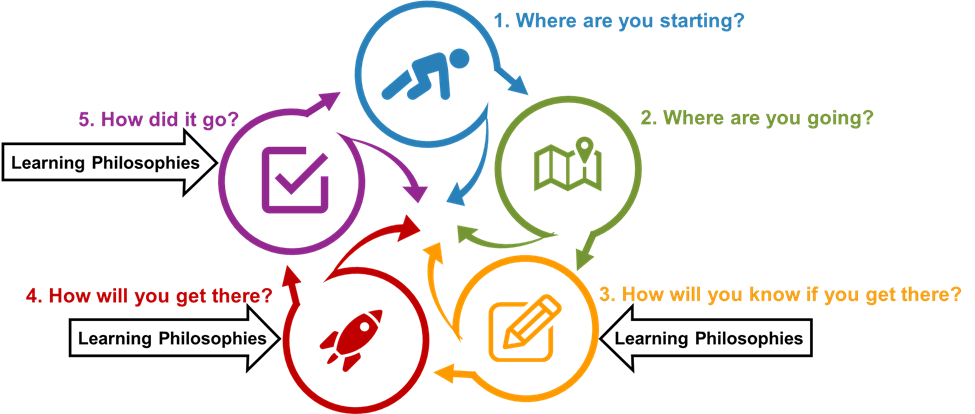
Unit A – Teaching & Learning Theories
A1. Learning Philosophies
Learning Philosophies
Your philosophy on the purpose of education will guide you in selecting an approach to teaching, such as interactions and activities, and will help you understand how you think about your students and their responsibilities for learning. It also can help you understand how your coworkers are teaching. Several guides are available that can lead you to identifying your philosophy of education (Conti, 2007; Jersin, 1972; Zinn, 2004).
Learning philosophies assume that learning is a process that results in a change in knowledge, skills, and/or attitudes resulting from experience, study, or by being taught. Most authors (such as Ertmer & Newby, 2013; GSI Teaching & Resource Center, n.d.; Ross, 2021; Schunk, 2015; Lee, 2016; Tritsch, 2021) discuss only three or four theories, typically cognitivism, behaviorism, and constructivism. Others discuss up to 15 (Learning Theories & Models – Summaries & Guides, 2022; Loveless, 2022).
While many theories exist, Merriam & Caffarella (1999, chapter 11) group learning theories into five philosophies, based on their major characteristics (See Table 1 for adapted version of their table). Each of these philosophies, and the more specific theories that fall into each philosophy, are useful based on the circumstances. Below are examples of the philosophies discussed by Merriam & Caffarella (1999, chapter 11) with some context for HE application.
Table 1: Five Learning Philosophies (adapted from Toutain & Byrne, 2012)
| Behaviorist | Cognitivist | Humanist | Social Learning | Constructivist | |
|---|---|---|---|---|---|
| Learning theorists | Thorndike; Skinner; Pavlov | Piaget; Kohler; Lewin | Maslow; Rodgers | Bandura; Rotter; Saloman; Piaget | Dewey; Piaget; Rogoff; Candy; Vygotsky |
| View of the learning process | Change in behavior | Internal mental process (including insight, information processing, memory, perception) | A personal act to fulfill potential | Interaction with and observation of others in a social context | Construction of meaning from experience |
| Locus of learning | Stimuli in external environment | Internal cognitive structuring | Affective and cognitive needs | Interaction of persons, behavior and environment | Internal construction of reality by individual |
| Purpose of education | Produce behavioral change in desired direction | Develop capacity and skills to learn better | Become self-actualized, autonomous | Model new roles and behavior | Construct knowledge and identity |
| Instructor’s role | Arranges environment to elicit desired response | Structures content of learning activity | Facilitates development of whole person | Models and guides new roles and behavior | Facilitates and negotiates meaning with learner |
| Keywords and concepts | Skill and competence development; Reinforcement; Contiguity; Operant conditioning; On the job performance | Prior knowledge; meta- cognition; perception; expertise and memory are important; learning style; learning how to learn | Human nature; Emotions and affect; Self-directed learning; Motivation (to learn); Choice and responsibility | Vicarious learning Self-regulation | Meaning making; Knowledge and experience; Cognitive conflict; Group discussion and collaboration |
Behaviorist Learning
Behaviorism focuses on observable performance. To get the desired performance, the instructor can provide conditioning (Pavlov’s dogs, for example) followed by positive and/or negative reinforcement to obtain the desired result. Repetition of appropriate behavior instills permanent learning. This is commonly referred to as stimulus-response conditioning.
Use in HE
Positive reinforcement through feedback can support student learning (see Chapter C10 on feedback). Ross (2021, p. 2) emphasizes that instructors should provide repeated practices with simulations to build stronger associations between stimulus and response. Conditioning may be particularly useful for psychomotor skills.
Cognitive Learning
Cognitivism builds on behaviorism, adding that students can learn by observation of other students, instructors, and situations (movies, simulations, readings, etc.) (Ross, 2021, p. 2). Cognitivism also theorizes that long-term and short-term memory are different (see Chapter A8). When students have internal conflicts, called cognitive dissonance, they work to resolve the emotional and cognitive differences (Bélanger, 2011, p. 23). Schema theory (see Chapter A2) fits within both cognitivism and constructivism.
Use in HE
Providing active learning can help students learn from more than just you and the homework. Teaching students about cognitive learning theory can also help them learn how to learn. Concept maps are a cognitivist strategy where students link concepts and issues visually.
Humanist Learning
Humanist learning focuses on the whole student, including physical and emotional aspects (Bélanger, 2011, p. 37). Students’ emotional attitudes impact their ability to learn. Self-actualization is a major tenet here.
Use in HE
Humanists might use individual learning contracts to encourage interest and provide self-directed learning experiences. Under this theory, it is important to help students feel safe and comfortable (Teaching & Education, 2020b). Teaching students about learning skills and strategies could also fit in the humanist theory.
Social Learning
Social learning considers observation of others as a learning event (Bandura, 1989, p. 21). If this is internalized and then reflected in the students’ behavior, the observation resulted in learning. For this reason, modeling and group work are important facets of social learning.
Use in HE
Basic instructional strategies include the flipped classroom, gamification and simulations, and peer coaching (Teaching & Education, 2020a).Team-based learning helps students learn collaboration and communication skills. In addition, research shows diverse members in group work can result in more creative solutions. Ross (2021, p. 2) states a key to student learning is self-reflection and self-regulation and that instructors can build this into activities.
Constructivist Learning
According to Ross, constructivism has a variety of definitions and offshoot theories. However, the main point of all constructivist theories is that because each student is different, each will construct their learning differently (Ross, 2021, p. 3). Realistic active application of material is therefore important.
Use in HE
Many professional training courses include simulations, mentoring and apprenticeships (Ertmer & Newby, 2013, p. 66). In other fields, students could be exposed to basic, authentic experiences which are made more complex as the students gain confidence. “Students gain familiarity with analysis and action in complex situations and consequently begin to expand their horizons: they encounter relevant books, attend conferences and seminars, discuss issues with other students, and use their knowledge to interpret numerous situations around them (not only related to specific design issues). Not only have the learners been involved in different types of learning as they moved from being novices to ‘budding experts,’ but the nature of the learning process has changed as well” (Ertmer & Newby, 2013, p. 67).
IDI & Learning Philosophies

The following describe actions you can take to use concepts from learning philosophies in the IDI model:
Step 3. How Will You Know If You Get There?
3.1 Develop Assessments & Rubrics
- Consider using individual learning contracts that encourage self-directed learning and a variety of assignment types.
- Use small group work to encourage students to learn from each other.
- Use real-world examples to connect the content to the student understanding.
3.2 Develop Instruments to Evaluate the Course
- Develop assessments such as student feedback which will help you improve your teaching.
Step 4. How Will You Get There?
4.1 Develop & Teach Course
- Provide opportunities for students to ask questions to clarify their thought processes.
- Have students build concept maps to help them see connections.
- Ensure you offer enough opportunities for students to build the stimulus-response condition.
- Ask questions that require students to explain their thought processes.
- Ask students for examples of content application in their life.
- Maintain a positive classroom environment to help students feel comfortable and safe.
- Debrief student discussions and assignments to promote self-reflection.
4.2 Assess Students
- Provide appropriate, positive, detailed feedback to support student self-reflection and improvement.
Step 5. How Did It Go?
5.1 Evaluate Course Success
- Reflect on each course session, student progress, and your course outcomes to identify how you these matched your teaching philosophy.
References
Bandura, A. (1989). Social Cognitive Theory. In R. Vasta (Ed.), Annals of Child Development. Vol. 6. Jessica Kingsley Limited.
Bélanger, P. (2011). Adult Learning-related Learning Theories. In Theories in Adult Learning and Education (1st ed., pp. 35–48). Verlag Barbara Budrich. https://doi.org/10.2307/j.ctvbkjx77.7.
Conti, G. J. (2007). Identifying Your Educational Philosophy: Development of the Philosophies Held by Instructors of Lifelong-Learners (PHIL). Journal of Adult Education, 36(1), 19–35.
Ertmer, P. A., & Newby, T. J. (2013). Behaviorism, Cognitivism, Constructivism: Comparing Critical Features From an Instructional Design Perspective. Performance Improvement Quarterly, 26(2), 43–71. https://doi.org/10.1002/piq.21143.
GSI Teaching & Resource Center. (n.d.). Overview of Learning Theories | GSI Teaching & Resource Center. GSI Teaching & Resource Center, Berkeley University of California. Retrieved July 17, 2022, from https://gsi.berkeley.edu/gsi-guide-contents/learning-theory-research/learning-overview/.
Jersin, P. D. (1972). What Is Your Ep? A Test Which Identifies Your Educational Philosophy. The Clearing House, 46(5), 274–278.
Learning Theories & Models—Summaries & Guides. (2022, August 9). Learning Theories. https://learning-theories.com.
Lee, T. (2016, February 25). Learning Theories: Behaviorism, Cognitivism, Constructivism, and Connectivism. Travis Lee. https://traviselearning.net/blog/2016/2/25/learning-theories-behaviorism-cognitivism-constructivism-and-connectivism.
Loveless, B. (2022, March 10). 15 Learning Theories in Education (A Complete Summary). Education Corner. https://www.educationcorner.com/learning-theories-in-education/.
Merriam, S. B., & Caffarella, R. S. (1999). Learning in Adulthood: A Comprehensive Guide (2nd ed.). John Wiley & Sons.
Ross, S. (2021). Simulation-Based Learning: From Learning Theory to Pedagogical Application. Internet Journal of Allied Health Sciences and Practice, 19(4). https://doi.org/10.46743/1540-580X/2021.2056.
Schunk, D. H. (2015). Learning Theories: An Educational Perspective, Pearson eText with Loose-Leaf Version — Access Card Package (7th Edition). Pearson.
Teaching & Education. (2020a, July 17). A guide to social learning theory in education. Western Governors University, Ohio. https://www.wgu.edu/blog/guide-social-learning-theory-education2005.html.
Teaching & Education. (2020b, July 17). What Is Humanistic Learning Theory in Education? Western Governors University, Ohio. https://www.wgu.edu/blog/what-humanistic-learning-theory-education2007.html.
Torre, D. M., Daley, B. J., Sebastian, J. L., & Elnicki, D. M. (2006). Overview of current learning theories for medical educators. The American Journal of Medicine, 119(10), 903–907. https://doi.org/10.1016/j.amjmed.2006.06.037.
Toutain, O., & Byrne, J. (2012, January 1). Learning theories in entrepreneurship: New perspectives. Academy of management.
Tritsch, E. (2021, September 24). The Three Learning Schemas: Behaviorism, Cognitivism, & Constructivism. Fairborn Digital Academy. https://fairborndigital.us/2021/09/23/the-three-learning-schemas-behaviorism-cognitivism-constructivism/.
Zinn, L. M. (2004). Philosophy of Adult Education Inventory. In M. W. Galbraith (Ed.), Adult Learning Methods: A Guide for Effective Instruction (3rd ed.). Krieger Publishing Co.
